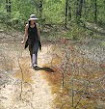Today and tomorrow the Carolinian Canada Coalition is hosting a two-day forum "Caring for Our Coast: Envisioning a Lake Erie Community Stewardship Trail Network"
Many of the presentations at this year's forum (located at Pt. Pelee National Park: just a-stone's-throw from where Gerry Waldron recently found a patch of Kudzu) have more of a southwestern ON focus.
I once knew the area well, for 25 years actually. Born and raised (yup, detassled a lot of corn, swam and ate from all 3 lakes, and later, as an archaeological field assistant, I shovelled a lot of wet clay). Nevertheless, this past spring, when I had to suss out some of the area's practical local native plant gardening, restoration and stewardship resources, I realized I had a lot more to learn.
Here are a few of the local native plant ecology resources I found handy down there:
- Carolinian Canada Coalition's Signature Sites and Natural areas, Significant Stewardship sites and Caring for Nature Factsheets by county
- Ontario Nature Network's member groups for Carolinian West
- The Naturalized Habitat Network of Essex County & Windsor's handy guide “The Naturalized Gardener’s Handbook for Windsor and Essex County” and their Naturalized Landscape Course (usually offered between January and April).
- Tallgrass Ontario especially if you're working in one of the sand plain areas, or if you're trying a few prairie->meadow species that can handle clay
the species occurrence maps in Gerry Waldron's Trees of the Carolinian Forest - A Guide to Species, Their Ecology and Uses - Nurseries who carry some species indigenous to the area: Natvik Ecological, Grand Moraine Growers, and Acorus, and Pterophylla Nurseries / Mary Gartshore gartcar@kwic.com
- Lake St. Clair Coastal Habitat Conservation and Restoration Plan's "Section II: Characteristics of the Lake St. Clair Ecosystem: II. B. Physical Characterization". Although this one's out of Michigan it includes good info about southwestern Ontario physiography and vegetation I didn't find through online Canadian resources. This US Geography Service's description of "Maumee Lake Plain" also helped, and Michigan's list of natural communities were insightful too.
- another take from a US (EPA) / Michgan perspective “Natural communities of the Lake Huron to Lake Erie Corridor” from "Explore Our Natural World A Biodiversity Atlas of the Lake Huron to Lake Erie Corridor > St. Clair Biodiversity"
- The Ontario Urban Forest Scrapbook I (I still need to buy Scrapbook II, apparently it's out and on sale) by Willem A. G. Morsink, specifically "Chapter 4 - Southwest Presettlement Forest from 1650-1800 - An Interpretation of the Tri-County Forest":
"...(F)rom 2000 years ago till AD 1650 in the Tri-County area of Windsor, Chatham and Sarnia, Ontario ...very few well drained sandy and sandy loam areas existed... There were extensive bottomland forests, wet prairies and the general ground water levels must have been 2-3 feet higher before the area was drained in the 19th century.He then goes on to map and list species in those forest communities "useful in classifying significant vegetation types, and ...site-suitable planting schemes for urban tree and woodland areas." -- Invaluable reference in a place where you often can't see the forests for the farms.
One can define four woodland-mapping units in the Tri-County area, which is part of the southwestern-Lake Erie section of the Deciduous Forest zone:
- Carolinian Upland Hardwoods
- Midwestern Clay-plain Hardwoods
- River and Lakeshore Hardwoods
- Oak-savannah"
*updates feb 2010*
"Coastal Zone Program: Next Steps Towards a Lake Erie Coastal Stewardship Trail" - CCC was flooded with interest from diverse groups at the successful launch of this initiative in October at our 'Caring for Our Coast' Forum. Insights from speakers and participants will be available soon in a program update and proceedings. Local workshops are being planned from Essex to Niagara for 2010. Join with our diverse partners, including landowners, trail groups, municipalities, habitat ecologists and more to showcase the beauty of Carolinian Canada. Stay tuned through regular updates by contacting coast@carolinian.org.
For more examples and other preliminary results from the forum, check out our new Factsheets:
1 - Lake Erie Coastal Zone Program (Download low res PDF 100KB, high res PDF 600KB)
2 - Next Steps Towards a Lake Erie Coastal Stewardship Trail (Download low res 200KB, high res 2MB)
Also, check out the upcoming CCC 2010 Forum!

No comments:
Post a Comment